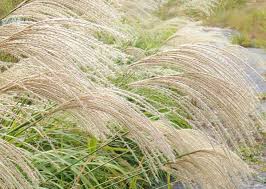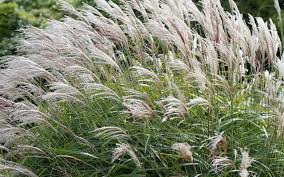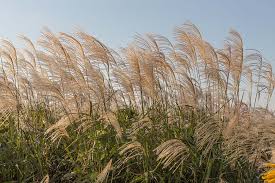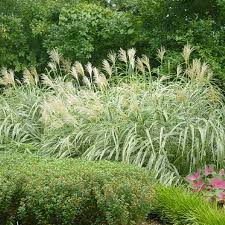Silver Grass ( Miscanthus sinensis) is a beautiful grass plant that grows in many gardens and landscapes. With its soft, feathery plumes and tall, elegant stems, Silver Grass adds a touch of nature’s grace to any space.
This plant is native to parts of Asia, including countries like China and Japan. It’s well-known for its ability to thrive in various climates and soil types, making it a popular choice for both beginner and experienced gardeners.
Silver Grass gets its name from the silvery appearance of its foliage, which shimmers in the sunlight and rustles gently in the breeze. It’s a hardy perennial, meaning it comes back year after year, bringing consistent beauty to your garden.
One of the great things about Silver Grass is its low maintenance requirements. Once it’s established, it doesn’t need much attention. Just make sure it gets enough sunlight and water, and it will reward you with its stunning display.
Gardeners often use Silver Grass as a focal point in their landscapes. Its tall and slender growth habit can create privacy screens, add vertical interest, or even soften harsh lines in a garden design. Additionally, the plumes that emerge in late summer and fall create a mesmerizing effect, especially when they catch the light.
In addition to its aesthetic appeal, Silver Grass also offers environmental benefits. Its deep root system helps prevent soil erosion, making it useful for stabilizing slopes or areas prone to erosion. Furthermore, it can be used as a habitat for birds and insects, contributing to biodiversity in your garden.
In addition, Silver Grass (Miscanthus sinensis) is a versatile and elegant plant that can bring beauty and charm to any garden. Its simple care requirements, stunning appearance, and various uses make it a popular choice for both novice and experienced gardeners looking to add a touch of nature’s elegance to their outdoor spaces.
Read Also: 9 Medicinal Health Benefits of Glycyrrhiza (Licorice)
Growing and Care Guide of Silver Grass

Growing and Care Guide for Silver Grass (Miscanthus sinensis):
1. Choosing the Right Location: Select a location that receives full to partial sunlight. Silver Grass thrives in well-drained soil, but it can tolerate a range of soil types.
2. Planting: Plant Silver Grass in the spring or early fall. Dig a hole that’s slightly larger than the root ball of the plant. Place the plant in the hole and backfill with soil, then water well to help it establish.
3. Watering: Water the plant regularly during its first growing season to help it establish a strong root system. Once established, Silver Grass is relatively drought-tolerant, but it will benefit from occasional deep watering during dry spells.
4. Mulching: Applying a layer of mulch around the base of the plant helps retain moisture, suppress weeds, and insulate the soil. This is especially important during the plant’s first year.
5. Fertilizing: In the spring, you can apply a balanced, slow-release fertilizer to provide nutrients for healthy growth. Follow the package instructions for the appropriate amount to use.
6. Pruning: In late winter or early spring, cut back the old foliage to make way for new growth. Trim the plant to a few inches above the ground, removing any dead or damaged parts.
7. Dividing: As Silver Grass matures, it can become overcrowded. Every few years, consider dividing the plant to rejuvenate it and promote healthy growth. Dig up the plant, divide the clumps, and replant the sections in their new spots.
8. Pests and Diseases:
Silver Grass is generally resistant to pests and diseases. However, keeping the plant well-maintained and not allowing it to become too crowded can help prevent issues.
9. Winter Care: In colder climates, the plant’s foliage may die back in the winter. Leave the dried foliage in place, as it can provide some protection to the plant’s crown during the colder months. You can remove the dead foliage in early spring.
10. Uses: Silver Grass can be used for various purposes, including as an ornamental grass in landscapes, as a privacy screen, or even in large containers. Its plumes make for beautiful dried flower arrangements.
Remember that every garden is unique, so it’s essential to observe your Silver Grass and adjust care based on its specific needs. With proper attention and care, Silver Grass can reward you with its graceful beauty for years to come.
Chinese Silver Grass

Chinese Silver Grass, also known as Miscanthus sinensis, is a beautiful plant that adds grace and elegance to gardens and landscapes. Its long, wispy leaves sway gently in the breeze, creating a soothing and calming atmosphere. This grass is native to East Asia and has become popular in gardens around the world.
Chinese Silver Grass is loved for its tall and feathery appearance. It can grow quite tall, reaching heights of 6 to 10 feet. In the fall, its plumes take on a lovely silver hue, giving it the name “Silver Grass.” These plumes can last well into the winter, adding visual interest to the garden even in colder months.
One of the great things about Chinese Silver Grass is its adaptability. It can thrive in a variety of soil types and can tolerate both sun and light shade. This makes it a versatile choice for different garden settings. It’s also relatively low-maintenance, requiring only occasional trimming to keep its shape neat.
Gardeners often use Chinese Silver Grass to create natural screens or borders. Because of its height and dense growth, it can provide privacy while still allowing a sense of openness. Additionally, the movement of its leaves and plumes can add a sense of movement and life to any garden.
However, Chinese Silver Grass is a stunning and versatile plant that can enhance the beauty of any garden. Its graceful appearance, adaptability, and low-maintenance nature make it a popular choice among garden enthusiasts worldwide. Whether used as a focal point, a screen, or simply to add texture and movement, Chinese Silver Grass is sure to bring a touch of elegance to outdoor spaces.
Japanese Silver Grass

Japanese Silver Grass, scientifically known as Miscanthus sinensis, is a captivating plant that brings charm to gardens and landscapes. Its delicate, long leaves gently sway in the wind, creating a peaceful atmosphere. Originating from East Asia, this grass has gained popularity worldwide.
Japanese Silver Grass is appreciated for its tall, feathery appearance. It can grow quite tall, reaching heights of 6 to 10 feet. During the fall, its plumes take on a beautiful silver color, earning it the name “Silver Grass.” These plumes remain visually appealing even into the winter, adding interest to gardens during colder months.
A notable feature of Japanese Silver Grass is its adaptability. It can flourish in various soil types and can tolerate both sunlight and light shade. This versatility makes it suitable for different garden settings. It’s also relatively low-maintenance, requiring only occasional trimming to maintain its appearance.
Gardeners often use Japanese Silver Grass to create natural screens or borders. Its tall growth and dense foliage offer privacy while maintaining an airy feel. Additionally, the gentle movement of its leaves and plumes adds a sense of liveliness to any outdoor space.
In addition, Japanese Silver Grass is a captivating and adaptable plant that enhances the beauty of gardens. Its graceful appearance, versatility, and easy maintenance make it a popular choice among garden enthusiasts globally. Whether as a focal point, a screen, or to introduce texture and movement, Japanese Silver Grass adds a touch of elegance to outdoor environments.
Read Also: A Guide to Growing and Caring for Stipa Grass (Stipa)
Benefits of Japanese Silver Grass

Here are six wonderful benefits of Japanese Silver Grass:
1. Aesthetic Appeal: Japanese Silver Grass brings an elegant and graceful look to gardens and landscapes. Its tall plumes and silver-colored leaves create a visually pleasing focal point, adding beauty and charm to any outdoor space.
2. Low Maintenance: This grass requires minimal care, making it an ideal choice for both experienced gardeners and beginners. It grows well in various soil types and can withstand different levels of sunlight, reducing the need for constant attention.
3. Year-Round Interest: The silver plumes of Japanese Silver Grass remain striking even through the winter months. This provides ongoing visual interest to your garden, adding a touch of elegance and vibrancy during seasons when other plants may not be as active.
4. Natural Screening: Due to its tall growth and dense foliage, Japanese Silver Grass can be used to create natural screens or borders in your garden. It offers a sense of privacy while maintaining an open and airy atmosphere.
5. Wildlife Habitat: The feathery plumes of Japanese Silver Grass can provide shelter and nesting sites for various birds. Its seeds are also a food source for birds and small mammals, contributing to local wildlife diversity.
6. Erosion Control: Planting Japanese Silver Grass on slopes or areas prone to erosion can help stabilize the soil. Its extensive root system helps prevent soil erosion by binding the soil particles together.
In summary, Japanese Silver Grass offers a range of benefits, from its attractive appearance and low maintenance requirements to its ability to provide year-round interest, natural screening, and support for local wildlife. Its versatility and aesthetic qualities make it a valuable addition to any garden or landscape.
Read Also: The Functions of Proper Marketing





